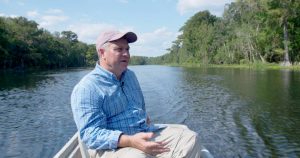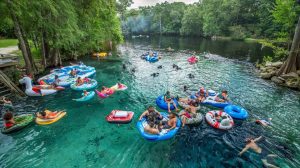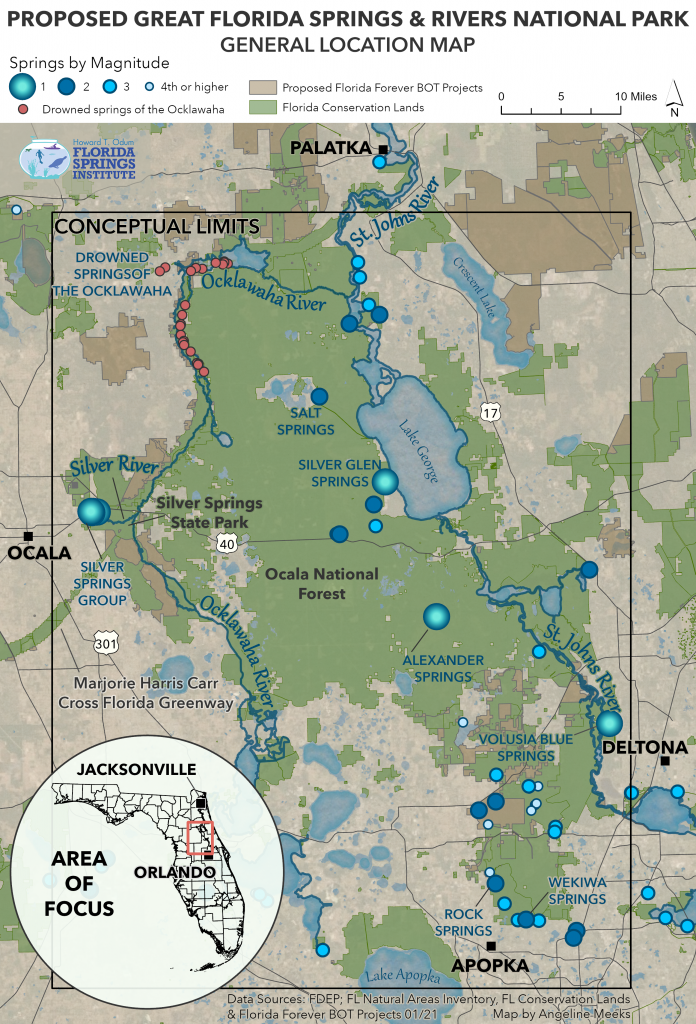By Oscar Corral, producer of “The Fellowship of the Springs”
Thomas Greenhalgh risked his job and career in 2019 when he sued his own employer, the Florida Department of Environmental Protection, to challenge the state’s plans to protect Florida’s imperiled springs from increasing pollution.
Greenhalgh, a veteran hydrogeologist and expert on the underground flows that feed North Florida’s springs, argued that the sandy soils and porous rock of the region made them especially vulnerable — a position supported by other springs advocates and independent scientists in a long-running lawsuit seeking tougher state restrictions on how surrounding farms and other industries use fertilizer.

The little-noticed ruling finally came down in February, overshadowed by a water management district decision the same week to allow the multinational conglomerate Nestlé to expand its lucrative bottled water business by drawing up to another million gallons a day from Ginnie Springs, a popular swimming and tourist spot. For springs advocates, the decision by administrative law Judge Francine M. Ffolkes would prove a double blow — one that actually carries much deeper implications for the precarious future of Florida’s springs.
She let the state rule stand. It basically compels farms to implement ineffective “best management practices” that allow them to comply with the rule — but without meeting water quality standards necessary for springs restoration or even drinking water in some cases.
“It’s shocking,” Greenhalgh said in a recent interview. “People in decision-making positions in government don’t understand the issue and they are being fed misinformation by others who have a stake in it or stand to gain economically from it.”
This legal drama is just part of an upcoming documentary covering two years of grassroots efforts to preserve the world’s largest collection of natural springs, “The Fellowship of the Springs.” (The two-part series was directed and produced by Oscar Corral, a former Miami Herald reporter and Emmy Award-winning filmmaker who also wrote this article). Part 1, Magic Waters, is scheduled to air on WPBT2 South Florida PBS at 11 a.m. on April 18 and again at 11 p.m. on April 21. Part 2, Blue Rebellion, is scheduled to air at 11 p.m. April 22 (Earth Day), and again at 11 a.m. April 25. The documentary is expected to air on PBS stations across Florida later this year.

Cruising on the Wacissa River in North Florida: Hydrogeologist Thomas Greenhalgh, a former employee of the Florida Department of Environmental Protection, sued his own employer in 2019. EXPLICA MEDIA
The documentary chronicles an ongoing, uniquely Floridian environmental saga.
It’s the only water conflict on earth, for example, where actual professional mermaids are among the activists standing in opposition to politically powerful industries and an industry-friendly state government they feel is practically giving away its publicly owned water supply. Frustrated by Florida’s response, some activists are now touting the idea of creating a new national park to revive and protect some threatened springs.
Here’s one thing that environmentalists and state regulators agree on: Many of Florida’s springs are at risk, largely from a combination of reduced water flow and increased pollution.
Protections fall short
But the Florida Department of Environmental Protection’s approach to protecting them is the subject of much dispute, generating the lawsuit in 2019. At the heart of the legal battle is something called a Basin Management Action Plan, known as a BMAP. There are BMAPs for degraded water bodies and systems across the state, each with the ostensible goal of identifying sources of pollution and proposing steps to reduce it.
Activists argued the state-drafted plans in some of the springs areas don’t live up to their role, falling gravely short on curbing pollution from agriculture — the biggest source of nitrate pollution in most springs in North Florida. They say the “best management practices” at the heart of the policy depend on farmers to decide how much they can reduce fertilizer use and are, practically speaking, ineffective and poorly regulated.

The Florida Department of Environmental Protection did not respond to multiple requests for comment for this article sent to Press Secretary Weesam Khoury. In an interview for the documentary, Thomas Frick, the FDEP’s then-director of the Division of Environmental Assessment and Restoration, said the department wants to restore the springs.
“Our goal really is to try and limit the amount of nitrogen that’s getting to the groundwater and then coming out of the spring,” said Frick, who left the agency a few weeks after the interview in late 2019. “And we do that through trying to be more efficient through processes, whether that’s wastewater processes, or fertilizer processes both on the urban and agricultural side.”
Records obtained through the Freedom of Information Act show that FDEP enforcement of environmental laws and regulations has plummeted over the last two decades. From 2000 to 2010, FDEP averaged around 1,600 enforcement cases per year, and averaged about $5 million a year in fines. From 2010 to 2018, that dropped to about 480 cases per year and about $1.3 million in fines, records show. The agency also faced steep budget and staff cuts in that period, records show.
Frick explained that in 2010, under former Gov. Rick Scott, “the shift was towards, you know, not going right to enforcement, was to really do compliance assistance.”
“But really, what it was in general was to go in where we saw bad actors to work with them in order to change the behavior, because in the end, it’s not about how much money we are getting from fines. It’s the environmental impact to that.”
The agency, however, was aware that “best management” alone doesn’t go far enough to safeguard the springs. In a statement to the Daytona Beach News-Journal in 2018, DEP’s then-Communications Director Lauren Engel said the standards the state had developed “clearly acknowledge that agricultural BMPs alone will not achieve the reduction goals.”
Ryan Smart, executive director of the Florida Springs Council, an umbrella group that brings together more than 50 organizations that advocate for Florida’s springs, believes politics dictated the BMAPs more than science. Despite the ruling, he also said BMAPs in certain springs areas fail to meet the standards of Florida law. Smart said that if the BMAPs are implemented as written, then the Springs Council will likely appeal Ffolkes’ decision.
“I think when you look at who runs DEP at the upper levels, it is clear there’s a bias toward the regulated industry,’’ he said. “All we are asking for is a plan that works and follows the law.”
Florida’s first tourist attractions
Central and North Florida contains the largest and highest concentration of fresh water springs in the world. Healthy springs are blue jewels that dot the forests in the northern part of the state, gushing fresh water from the aquifer and creating pristine pools and rivers of clear blue water.
The most popular of these swimming and diving sites, visited year-round by hundreds of thousands of tourists, include: Silver Glen and Alexander Springs in the Ocala National Forest; Ichetucknee and Gilchrist Blue Springs near Gainesville; Rock and Blue springs near Orlando; and Weeki Wachee and Rainbow Springs north of Tampa.
The springs were the state’s first tourist attraction, with places like Silver Springs, Weeki Wachee and Wakulla Springs attracting snowbirds from the Northeast and visitors from around the world in the late 19th and early part of the 20th centuries. Today, any visitor to Disney World can stroll along Disney Springs’ imitation spring run modeled after its authentic counterparts nearby.
The springs also represent significant historical and folkloric value to Florida. Spanish explorer Juan Ponce De Leon was believed to have searched in vain for the fountain of youth, a search some believe was triggered by Florida’s springs.
But the damage to the springs is evident. Three of the largest springs on earth — Wakulla, Rainbow and Silver — are all showing signs of profound struggle. Wakulla is now dark green from pollution and no longer clear on most days; Silver, once the biggest spring in the world, has lost more than 30 percent of its flow, according to the Florida Springs Institute; and Rainbow, which has also lost more than 20 percent of its flow, is facing pressure from surrounding developments and a decision by the Southwest Florida Water Management District in 2019 to allow more water to be pumped from its basin.
“The springs are priceless from a standpoint that they are unique. They are supposed to be protected by the state,” said Howard T. Odum Florida Springs Institute Executive Director Robert L. Knight. “The state is also in the business of protecting the interests of for-profit corporations and they seem to have more of an interest in that.”
Scientists from the three water management districts where the most springs are located all agree that the springs are in trouble.
‘Concerns’ don’t stop state permits
“We do have concerns about the health of our springs,” said Jennette Seachrist, the natural resources director for the Southwest Florida Water Management District in an interview for the documentary. “We have five first magnitude springs in our district and we have seen declines in their health over the years.”
Yet all three districts also continue to approve permits and policies that allow more water to be pumped from the springs basins, mostly for agriculture and industries such as mining and development.
Many activists also don’t think their concerns get a fair hearing on boards appointed by governors, most recently, business-first Rick Scott and Ron DeSantis. For more than a decade, board members have often represented the same business interests that benefit from the massive use of free water.
“I do not think the water management districts are doing their job,” said Michelle Colson, known as Mermaid Michi, who leads a group of activist mermaids and has a sizable social media following. “Their job is to protect our water. I think they’re actually failing miserably.”
Greenhalgh, who decided to retire from FDEP last year, said his former employer is also failing in its mission to protect Florida’s springs. For example, he said FDEP is unable or unwilling to curb nitrate pollution from agriculture in sensitive springs sheds in North Florida, where the intensive agriculture industry has expanded in the last 40 years.
“The real truth is that a lot of people [at FDEP] just want to keep their jobs, and they are unwilling to make an issue out of it,” Greenhalgh said. “I wouldn’t go along with the flow. They tried to fire me multiple times over different issues.”
Greenhalgh said the biggest problem with agriculture in North Florida’s karst geology is that farmers are “growing crops in sand and it doesn’t have the capacity to hold nutrients.” He said the nutrients, as well as the large amount of water needed to keep the soil moist, all flow straight through the ground and into the Floridan aquifer. The aquifer provides drinking water to most of Florida, and also feeds the springs.
“In my opinion, we shouldn’t have intense agriculture in areas of the state where the geology is such that you are just going to contaminate the groundwater and decrease water supply,” said Greenhalgh, whose family owns a spring along the Suwannee River. “And the Suwannee River basin fits that.”
He believes the risk goes beyond the springs to the Floridan aquifer, the fresh water supply for most of North Florida.
“This will all come to a head when we have 35 million people living here and we go into a drought and the water supply isn’t there,” he said. “Then they will see what is happening.”
A national park for springs?
One idea to help protect the springs is to create a Florida springs national park in North Florida in an area that stretches from Silver Springs to the Ocklawaha River and down to the St. Johns River, where much of the land is already publicly owned.
The Ocklawaha River on the northern rim of Ocala National Forest is an environmental calamity, a swollen reservoir created for a failed project to cut a canal across the center of the state more than 50 years ago.
The Cross Florida Barge Canal idea, which intended to create a Panama-canal type waterway, was abandoned more than half a century ago. But the scars of its early efforts remain. The reservoir drowned 10,000-15,000 acres of forest and 20 springs. The tops of dead trees still litter the polluted waterway.
Now, activists in North Florida are pushing to remove the aging Rodman dam that created the reservoir, restore the Ocklawaha River and the 20 springs that were drowned by the reservoir.
“The Silver Springs and Ocklawaha River area have all the ingredients for a national park,” said Margaret Spontak, chair of the Free the Ocklawaha River Coalition. “The potential for Governor DeSantis and congressional leaders to create an integrated park plan for a magnet outdoor recreation area is tremendous.”
When asked about the springs national park concept, U.S. Department of Interior Press Secretary Tyler Perry said “we don’t have anything to share on this.”
The national parks system has been in expansion mode lately, particularly in areas around water. In 2019, the Department of the Interior designated Indiana Dunes National Park on the southern shores of Lake Michigan. And in December, the department designated New River Gorge National Park in West Virginia.
“I actually see it as a wonderful opportunity for our state administration and the new presidential administration to have a bipartisan approach to celebrating our world-renowned springs by creating a national park,” said St. Johns Riverkeeper Lisa Rinaman. “Florida springs are one of the most iconic water features of our country and the world.”
Oscar Corral, a former Miami Herald reporter, is the director and producer of the upcoming documentary series “The Fellowship of the Springs.” For more information visit www.floridaspringsfilm.com
“The Invading Sea” is the opinion arm of the Florida Climate Reporting Network, a collaborative of news organizations across the state focusing on the threats posed by the warming climate.





I am concerned with the toxins released from vehicle tires on all roads. In Citrus County, Fl, the retention ponds collect the run-off waters from the
roads and this all seeps through the ponds into the Fl Aquifer and our drinking water and local estuaries and Gulf. My wish would be
for all the retention ponds to be redone with clay bases and creating an evaporation pond instead. Do you believe this
is possible or reasonable? For long term relief, I believe we must be thinking and acting with long term solutions.